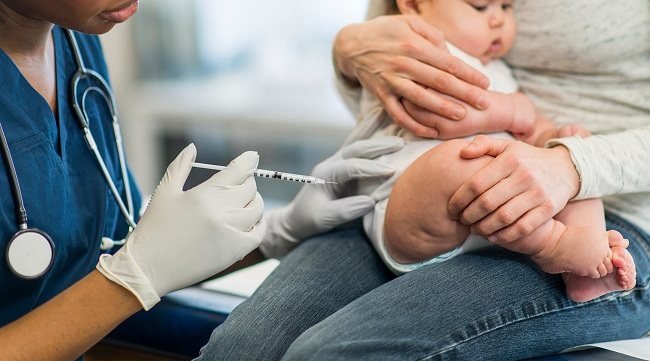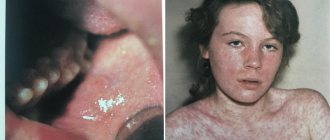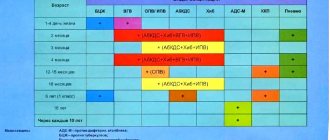Vaccine options
All modern vaccines for the prevention of viral hepatitis B are produced using genetic engineering technology.
A segment of the virus genome is introduced into the genetic material of baker's yeast, which is responsible for the production of the “Australian” (HBsAg) antigen. Vaccines consist of almost 90-95% antigen and only 5-10% of other components. The following vaccinations are used in Russia: “Vaccine against hepatitis B recombinant”, “Regevac V”, “Engerix V”, “Bubo-Kok”, “Bubo-M”, “Shanvak-V”, “Infanrix Hexa”, DPT-GEP B All of these vaccines are weakly reactogenic, interchangeable - that is, the course of vaccinations can be started with one vaccine and finished with another (although it is still preferable to vaccinate within the course with a vaccine from the same manufacturer). They are intended for vaccination of children and adults against hepatitis B.
The second, non-specific, but important component of vaccines is aluminum hydroxide. This substance is a so-called depositing agent in vaccinations and is designed to enhance the immune response. Its purpose is aimed not only at strengthening the immune response, but also at the dosed release of antigen from the site of hepatitis B vaccination. The need for it is dictated by the fact that, as a rule, vaccines based on only one antigen are weakly immunogenic, and in order to achieve the required levels of formed antibodies require either the introduction of more antigen or an increased response to it.
How the drug works
The surface antigen for vaccines is isolated from yeast cells that are produced using genetic engineering methods. Genes contained in cells encode HBV surface antigens. The antigen is then purified using chemical reactions.
When the drug enters the human body, it promotes the formation of antibodies to the virus, which protect the patient from infection.
The formation of immunity occurs in several stages:
- Formation of vaccine anigenesemia (appearance of surface antigen in the blood).
- The appearance of immune antibodies.
- Formation of immune memory that provides protection against the virus.
Antibodies in the blood
The final immune response is formed 3-4 months after the full course of immunization. 85% of patients have antibody levels above 100 mIU/ml.
If it is in the range of 10-90 mIU/ml, then it is considered weak and the patient requires revaccination. In some people, the immune response does not form at all, that is, antibodies are below 10. This can happen under the following conditions:
- The patient is already infected with hepatitis.
- The person is over 45 years old.
- There is obesity.
- A person abuses alcohol and nicotine.
- Patients use immunosuppressive drugs.
- The patient has AIDS.
In the absence of an immune response, a complete examination of the patient should be carried out to determine the cause and further tactics should be chosen. Some people need to get higher doses of the vaccine again. If a person is infected with the virus, then treatment begins.
Vaccinated people who have given an adequate immune response develop long-term protection against HBV, which lasts for 25 years. Patients at risk, such as medical workers, need revaccination every 5 years.
Principles and purposes of vaccination
About 780,000 people die every year from the consequences of hepatitis B. Vaccination is not only the main and important means of preventing viral hepatitis. It may also protect against primary liver cancer. The basis for preventing hepatitis B is the vaccine against this disease. WHO recommends that all infants should receive hepatitis B vaccination as soon as possible after birth, preferably within 24 hours. The dose given at birth should be followed by two or three subsequent doses to complete the vaccination series. In most cases, one of the following two options is considered optimal:
- a three-dose hepatitis B vaccination regimen, in which the first dose (of monovalent vaccine) is given at birth, and the second and third doses (of monovalent or combination vaccine) are given at the same time as the first and third doses of DPT vaccine;
- A four-dose regimen in which the first dose of monovalent vaccine given at birth is followed by 3 doses of monovalent or combination vaccine, usually given along with other vaccines as part of routine childhood immunization, is indicated for children born to mothers infected or with hepatitis B.
After a full series of vaccinations, more than 95% of infants, children of other age groups and young adults develop protective antibody levels. Protection lasts for at least 20 years and possibly a lifetime. All previously unvaccinated children and adolescents under 18 years of age should receive the vaccine if they live in countries with low or moderate endemicity. By the end of 2013, hepatitis B vaccine for infants had been introduced nationally in 183 countries. Global coverage of three doses of hepatitis B vaccine is estimated at 81%, and for Western Pacific countries it reaches 92%.
Symptoms
From the moment the pathogen enters the body until the first clinical signs, it takes from 2 to 6 months. First, viruses accumulate in the liver, and when the maximum concentration is reached, acute hepatitis begins.
It can occur in an anicteric form, then its symptoms are confused with other diseases. In most cases, the immune system copes with the infection, and the person becomes immune forever.
But in 20% of patients, HBV becomes chronic and begins to destroy liver cells. Hepatocytes are gradually replaced by connective tissue, which leads to the complete loss of the organ’s functions.
The first signs of the disease usually go unnoticed because they are not specific. A person develops weakness, fatigue, headache, and indigestion. These symptoms soon disappear due to the undulating course of the disease.
The disease is diagnosed very late, when most liver cells are destroyed. The patient develops skin itching, the liver becomes enlarged, appetite worsens, and various bleeding occurs. Death occurs from developed complications: cirrhosis, cancer, ascites, peritonitis, sepsis.
With timely diagnosis and correct treatment, patients live long enough. However, the cost of drugs is very high; no more than 3% of patients can receive treatment from the state. The rest have to either purchase medications at their own expense or not receive treatment.
To date, not a single medicine has been invented that can destroy the hepatitis B virus. Therefore, the only way to avoid infection is vaccination.
Vaccine effectiveness
The vaccine is highly safe and effective. More than one billion doses of hepatitis B vaccine have been administered worldwide since 1982. In many countries where typically 8% to 15% of children had chronic hepatitis B virus infection, vaccination has helped reduce rates of chronic infection among immunized children to less than 1% .
After a course of immunization, sufficient immunity is developed in 90% of vaccinated people. Vaccinations can reduce the incidence of hepatitis by 30 times and prevent at least 85-90% of deaths due to this disease. In addition, the risk of getting sick in those born to mothers who are carriers of the infection is reduced by 20 times.
Many researchers call the hepatitis B vaccine the “first cancer vaccine” because it prevents the development of HBV infection, which ultimately leads to hepatocellular carcinoma.
Why should BCG-M be vaccinated in the maternity hospital?
- Firstly, to protect the child from the very first days of life.
- Secondly, the effectiveness of BCG-M decreases over time (it must be administered before a year, but some pediatricians believe that after 6 months it no longer makes sense).
- Thirdly, the younger the child, the lower the likelihood of complications - inflammation of the lymph nodes or cold abscess.
Skillful administration of the vaccine also reduces the likelihood of complications. The BCG-M vaccine is administered strictly INTRADERMALLY! Nurses in the maternity hospital carry out BCG vaccination daily, constantly and en masse: they, as they say, “have their hands full”, but in clinics they do this vaccination infrequently and therefore more often “miss”.
Post-vaccination reactions
Modern vaccinations against hepatitis B are characterized by an extremely high degree of purification, up to 95% of their volume is represented by antigen. In addition, vaccinations consist of only one antigen, the content of which is measured in micrograms. Both of these factors determine that in practice these vaccines are among the safest, “mildest”, and easily tolerated.
The most typical post-vaccination reactions to hepatitis B vaccines are local reactions (ie, those occurring at the injection site). Their frequency is fairly standard for all available vaccines - up to 10% (maximum) of vaccinated people report symptoms such as redness, slight thickening, and discomfort during active movements. The prevalence of local reactions is explained by the action of aluminum hydroxide, a substance that is specifically designed to enhance the inflammatory reaction at the site of drug administration so that as many immunocompetent cells as possible come into contact with the injected antigen.
Much less frequently, with a frequency of about 1% (maximum - 5%), the so-called so-called general reactions, i.e. affecting the body as a whole - a slight increase in body temperature, mild malaise, etc. All of the above reactions are normal (expected), appear within 1-2 days from the moment of vaccination and disappear without treatment within 1-2 days.
Injection site
It is recommended to puncture in the upper third of the thigh. The justification is that even a baby has enough muscle in this area. Children from 3 years of age and adults are given an injection in the upper third of the shoulder - it is comfortably located and the entire volume of the drug is administered in one injection. A baby cannot be given an injection in the buttock - everyone here has a pronounced fat layer - the benefit from the vaccination will be minimal. Large vessels and nerves are also located here - there is a high risk of injuring them.

Contraindications
The only specific and absolute contraindication for vaccines against the hepatitis B virus is an allergy to products containing baker's yeast. Temporary contraindications: severe reaction (temperature above 40oC, swelling, hyperemia > 8 cm in diameter at the injection site) or complication (exacerbation of chronic diseases) to the previous administration of the drug. Routine vaccination is postponed until the end of acute manifestations of the disease or exacerbation of chronic diseases. For mild ARIs, acute intestinal and other diseases, vaccinations can be carried out after the temperature has normalized.
Complications
The incidence of vaccination complications does not exceed 1 case per 100 thousand. Possible undesirable consequences include:
- hives;
- skin rash;
- anaphylactic shock;
- erythema nodosum.
To minimize the risk of complications, manufacturers are trying to reduce the amount of preservatives in the vaccine or completely eliminate them.
According to WHO research, vaccination does not have a negative effect on the nervous system, so information about the development of multiple sclerosis after immunization is nothing more than rumors. Complications are most often caused by non-compliance with recommendations for preparing a newborn for vaccination, poor quality of the vaccine, as well as the infant’s individual intolerance to this vaccination.










